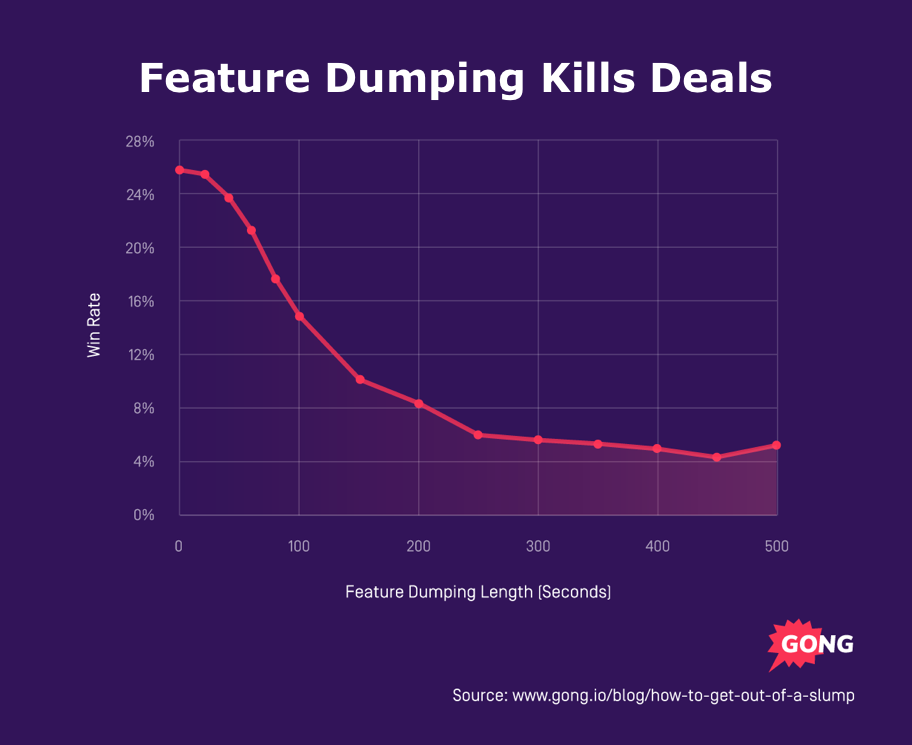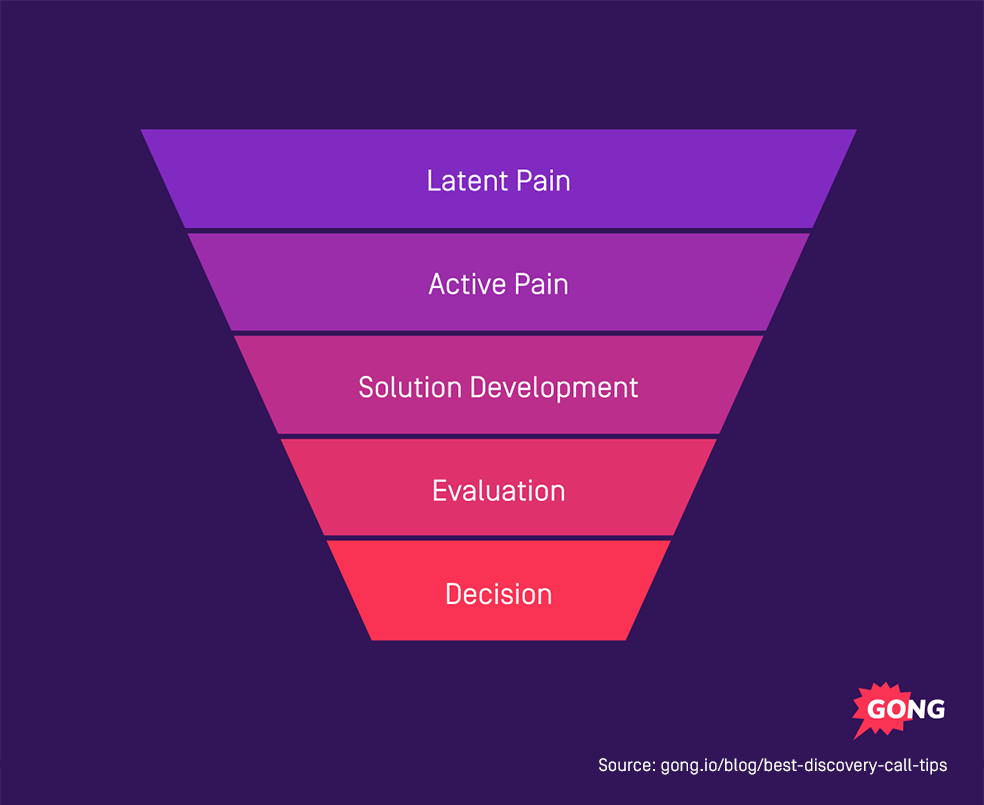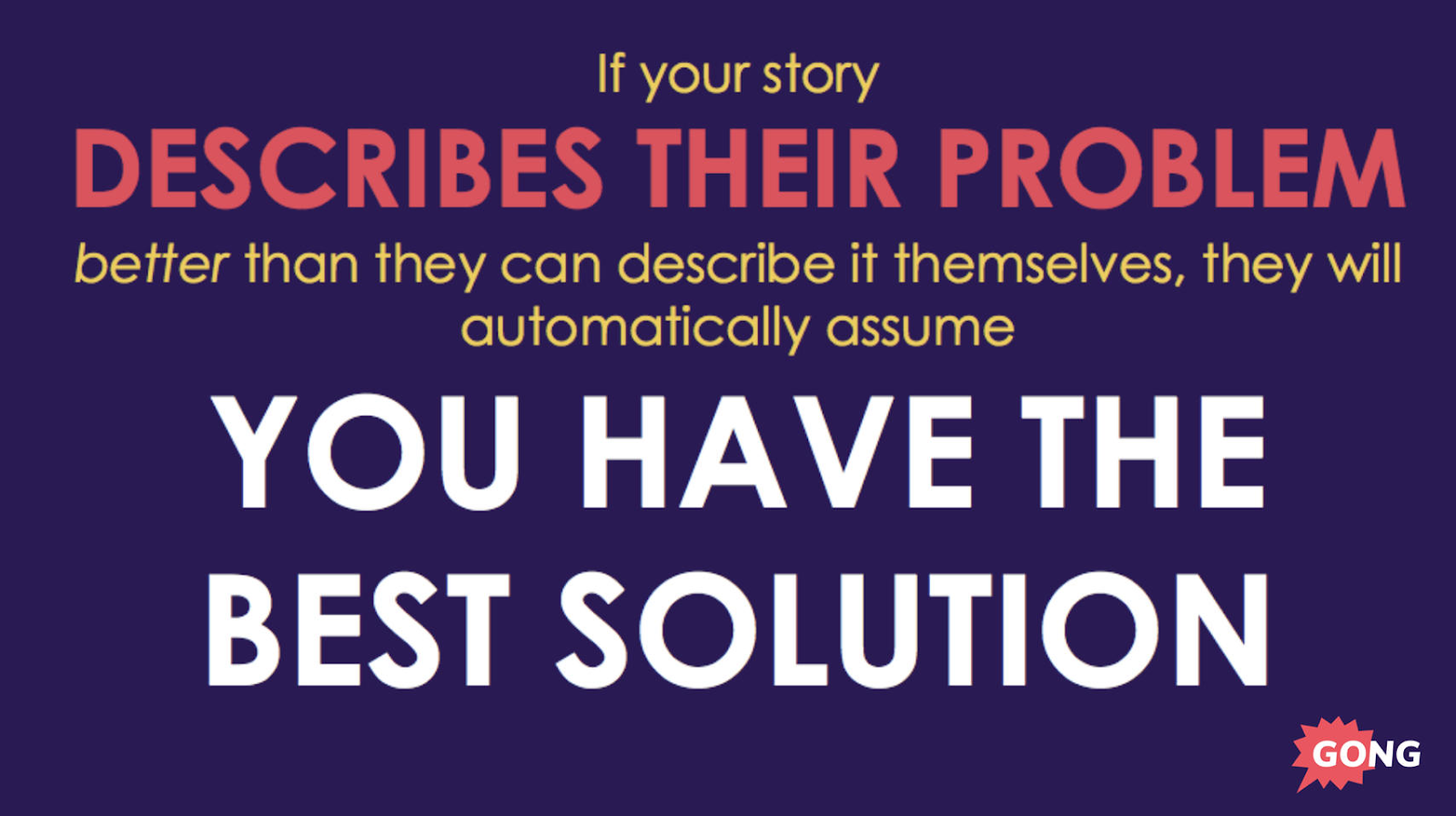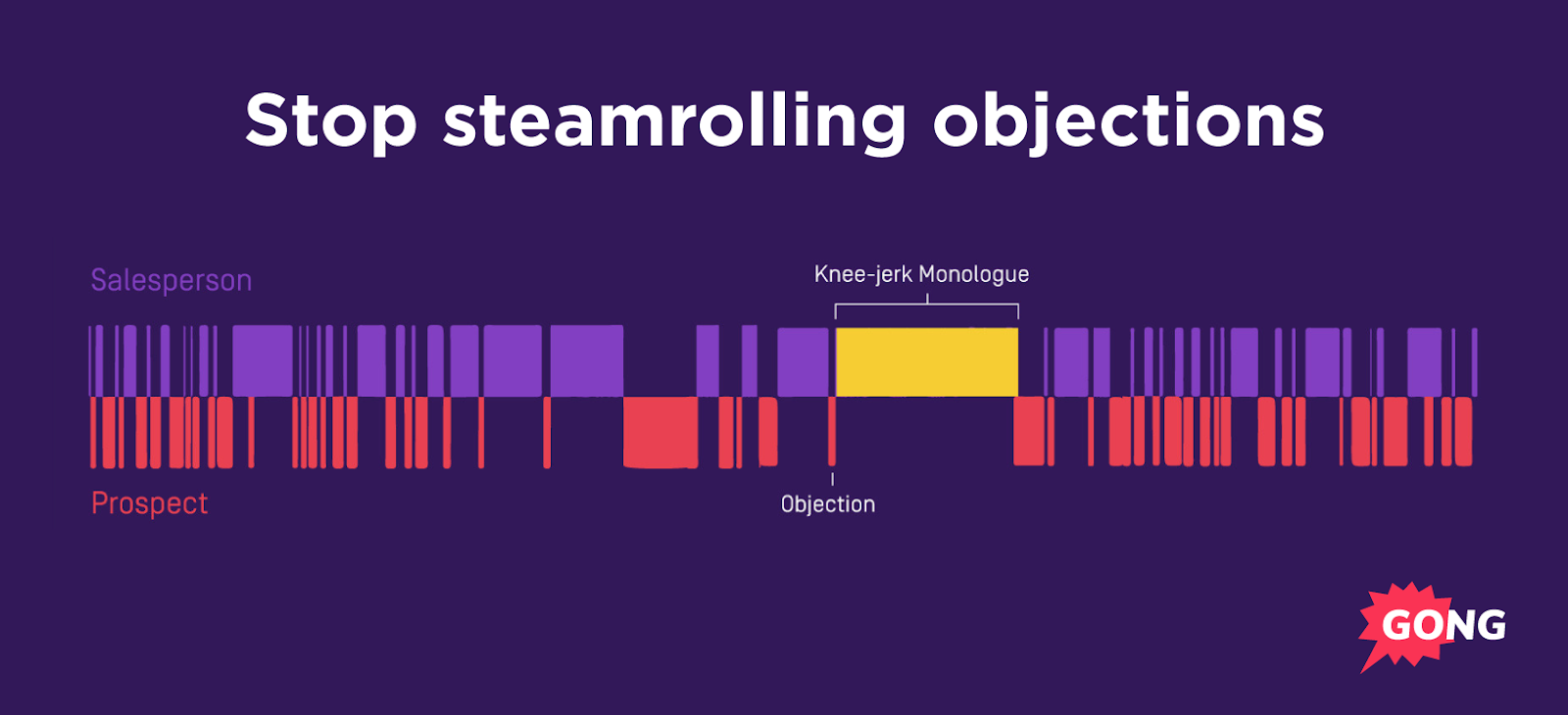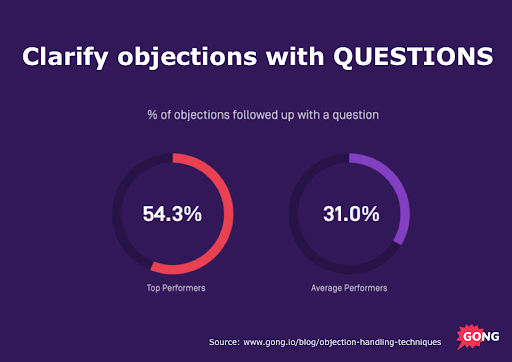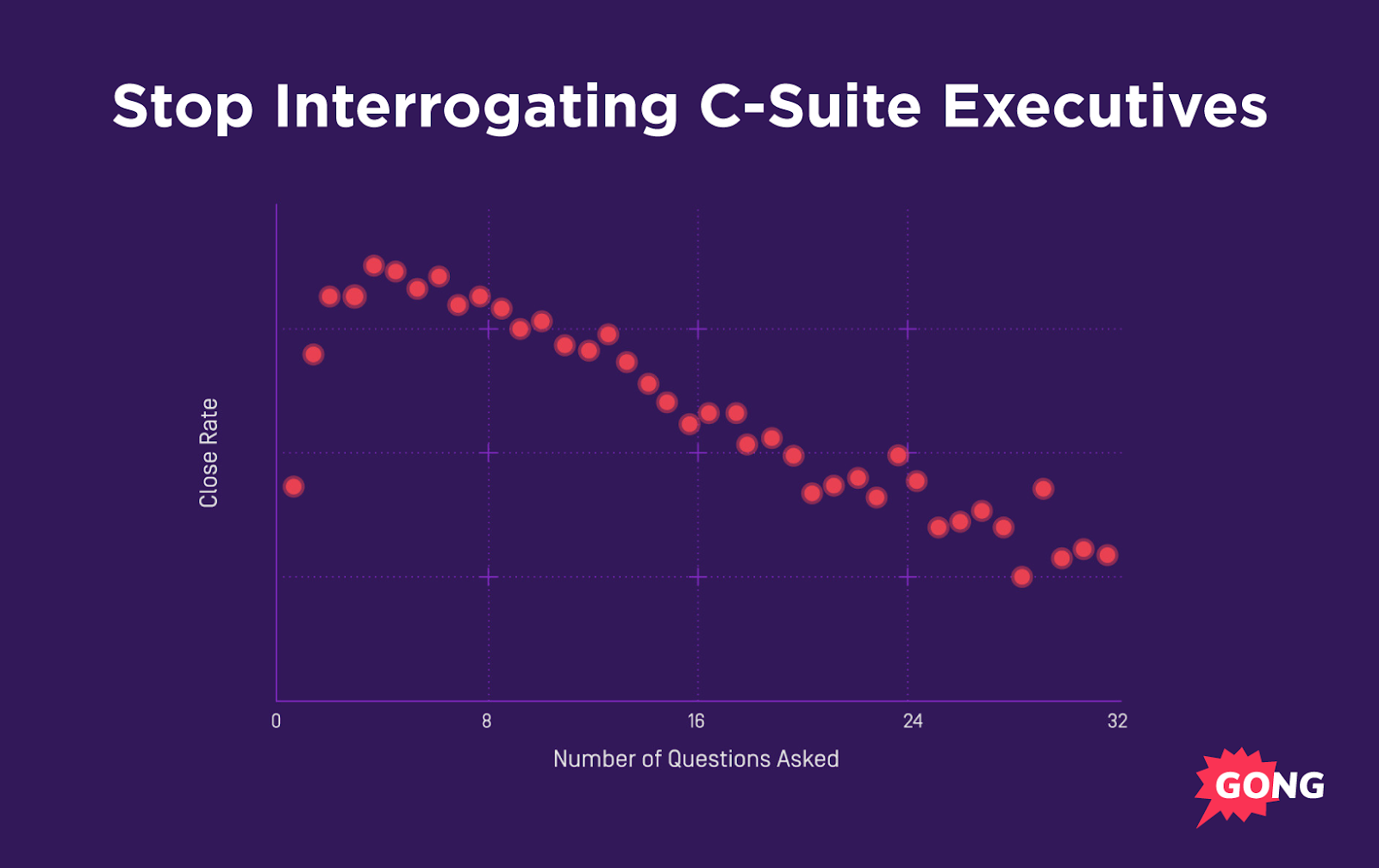The 7 most horrifying sales call mistakes of 2019
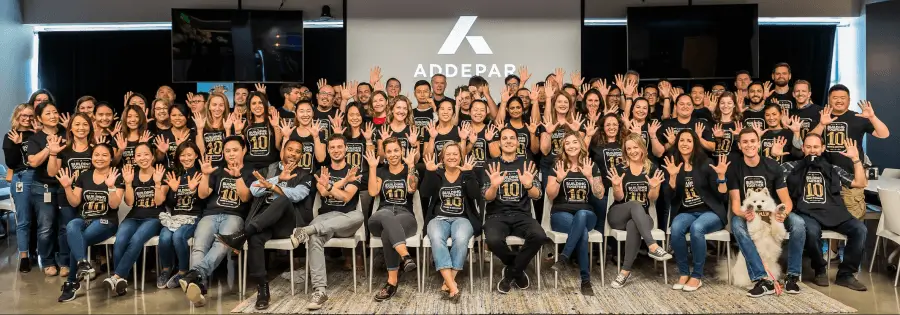
In the Gong Labs series, you get data-driven sales tips from our analysis of millions of recorded sales conversations. Subscribe here.
These 7 sales call blunders are just that: Horrifying.
How many of them do YOU make?
If you stop doing these, you’ll improve your calls. Big time.
Once you read what NOT to do, I have something for you at the end of this post:
What you SHOULD do to be successful instead.
ONE: “Feature dumping”
Feature dumping is to sales what bad breath is to dating. It kills “what could have been.”
What is “feature dumping” exactly?
It’s when you describe your product’s generic features and benefits at length. Hoping something sticks.
According to our data, it’s the ultimate deal killer. It makes your win rate plummet:
If you’re a sales manager, this is the number one behavior to get rid of on your team.
Everyone knows not to feature dump.
So why is it STILL so common?
Most salespeople are overtrained on their products and undertrained on sales skills.
Here’s a fix for that: Sign up for our free Sales Success Master Class video series.
You (and your reps) will come out the other end with a completely different skill set.
TWO: Asking annoying questions
Have you been here before?
You’re in the middle of a discovery call and your buyer blurts out:
“Can you just show me the product?”
Ouch.
There are two reasons this happens. Here’s the first one:
Your questions didn’t respect your prospect’s stage in the buyer’s journey:
Most salespeople are trained to start by diagnosing a buyer’s problems.
But that only works if your buyer is in the first two stages of that funnel, when they’re thinking through the problem.
What if your buyer is past that stage? What if they’re now evaluating solutions?
In that case, asking about problems is misaligned with where they are in their journey.
And it creates friction. It irritates your buyer.
A better starting question is:
“What are you hoping to achieve with X solution?”
That question matches the buyer’s stage in their journey.
Make sure your questions do the same.
NOW … Here’s the second reason buyers become abrupt during your discovery efforts:
THREE: Not earning the right to ask questions
Your buyer must “feel” that answering your questions is time well spent.
They should believe it brings them closer to their most important goals.
To do that, you have to earn the right to ask questions.
This is especially true in outbound deals (versus inbound deals, when the buyer is actively looking to solve their own pain).
What’s the best way to earn the right to ask questions during an intro sales meeting?
START with a “discovery prompter.”
What’s a discovery prompter?
It’s a short pitch (~3-5 minutes) about a business problem you solve or an opportunity you help buyers exploit.
Hint: It’s not about your product. It’s about your buyer’s problem.
It should adhere to this principle:
Resonant customer stories are GREAT discovery prompters.
If you spend 3-5 minutes STARTING a meeting with a well-crafted customer story … and THEN pass the torch to your buyer by saying:
“Enough about us. Help me understand YOUR biggest challenges”
… the floodgates will open.
If your story strikes a chord with your buyer, they’ll immediately engage in a rich discovery conversation.
Now, compare that approach with STARTING your meeting with the same question, but no discovery prompter.
It comes across crass and green.
FOUR: “Steamrolling” objections
Here’s what most salespeople do with an objection:
They immediately address it with a wordy answer, almost interrupting their buyer.
In a word, they steamroll the objection.
When you steamroll objections, a few bad things happen:
- The customer doesn’t feel understood.
- You come across as insecure.
- Your answer is more likely to be off the mark because you didn’t fully understand the objection.
Instead of steamrolling, respond to objections with clarifying questions:
Careful though!
Don’t simply ask “why,” which comes across as threatening.
Instead, use this question:
“Can you help me understand what’s causing that concern?”
That question asks “why” without any negative effects.
FIVE: One-size-fits-all social proof
Are you selling to a local restaurant? Then don’t name drop WalMart as a customer of yours.
Are you selling to a hospital? Then stop referencing your Google customer case study.
Are you selling to a fast-growing tech company? Then they won’t care how Chevron uses your product.
There’s a simple rule here: Match your name drops and customer stories to the buyer you’re speaking with.
SIX: “Grand finale” product demos
Most salespeople do ramp-up-style product demos, where they “save the best for last.”
They believe (incorrectly) that they’re building positive anticipation.
But your buyers want to see the end result right at the beginning. And THEN peel back the onion from there.
Here’s an example.
Let’s say you’re pitching a politician on building a new city.
Most salespeople would approach that pitch in this logical (but ineffective) manner:
Ms. Politician, we start with this empty plot of land:
It doesn’t look like much yet. BUT JUST YOU WAIT!
In a few years, we’ll have some roads, sidewalks, trees. Maybe we’ll even have our first stoplight!
Bear with me! We’re just getting to the good part …
A few years later, we’ll have residences and even a few local businesses! Maybe WalMart will move in.
Our burgeoning city will keep chugging along, reaching new heights of metropolitan greatness.
After a decade or two, we’re going to have ourselves a thriving, BEAUTIFUL city, rivaling Manhattan!
Let’s unpack that for a minute.
The seller thought he was doing it right by building anticipation and leading up to the grand finale.
But Ms. Politician is busy.
It probably took 30 minutes to get to the end point.
All the while, Ms. Politician was impatiently waiting to hear the rep’s key takeaway.
Let’s start over. Here’s what a GREAT pitch sounds like.
Ms. Politician, we have a bold vision for a new city. We’ve worked on the plans, and if we follow them, it will look like this:
I’m happy to walk you through our plans at whatever level of detail you’re interested in.
See how different that is?
The second pitch sold the buyer on the END RESULT, right up front.
It started with the outcome and let the conversation unfold from there.
SEVEN: Giving senior executives “discovery fatigue”
There’s a time and place for discovery.
Your meeting with a c-suite executive is not one of them.
According to our data, asking senior executives too many discovery questions correlates strongly with losing the deal:
What’s going on here? Weren’t you trained to ask questions early and often?
The truth is, senior executives (SVP and higher) have discovery fatigue.
Your job is to do discovery at different layers in the organization.
So by the time you get to the c-suite, they’re not teaching you about their company. YOU’RE teaching THEM.
The c-suite is interested in learning a new perspective. They want to hear something insightful they haven’t thought of before — something that will make their company better.
Do discovery with lower-level staffers. And then deliver a shiny new insight to the c-suite.
Deal won.
Now that you know what NOT to do …
Here’s what you SHOULD do to be successful:
Sign-up for our FREE Sales Success Master Class video series.
It’s designed to help you build a SYSTEM of sales skills that skyrocket your success.
Here’s how it works:
There are five carefully crafted training videos. Each one is 15 to 50 minutes long and addresses a pillar of sales success:
- Discovery call mastery
- Presentations that sell
- Objection handling mastery
- Storytelling that closes deals
When you sign-up, you can access the first video immediately.
You’ll get one more video every few days.
Ready to take it for a spin?
Sign-up for the Sales Success Master Class video series for FREE here:
All signed up? GREAT!
Now, before you go …
What bad sales call habits drive YOU crazy?
Tell me your thoughts in the comment section below.
Which ones did I miss?
Which ones from this list irk you the most?
